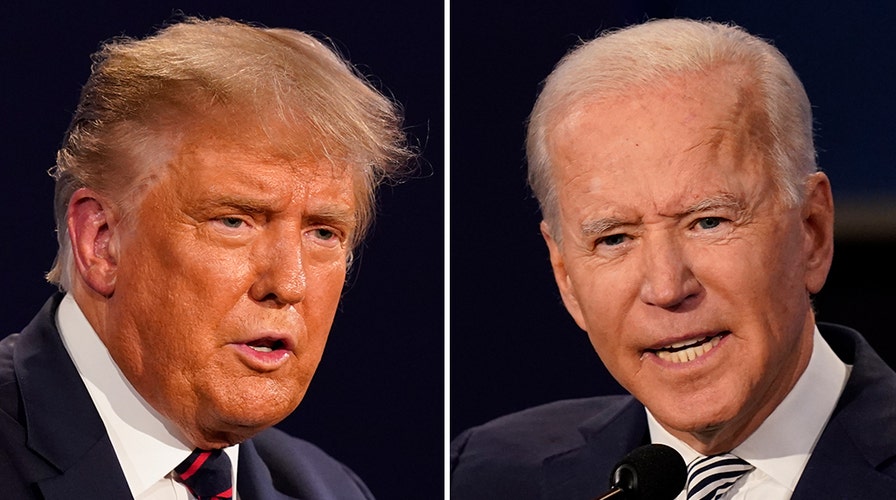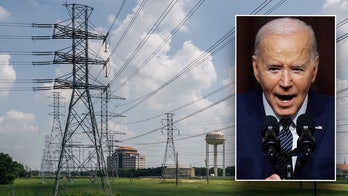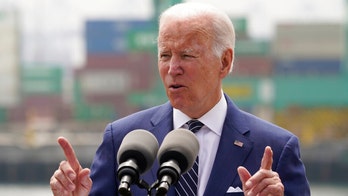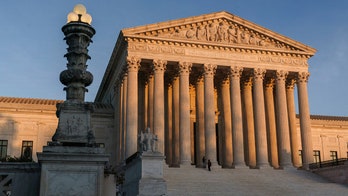How does Trump's COVID-19 diagnosis impact the 2020 election?
Fox News contributor Kristen Soltis Anderson joins 'The Next Revolution' to discuss how President Trump's COVID-19 diagnosis and last week's debate impact the 2020 election.
With Pennsylvania set to be one of the most important states in deciding the 2020 presidential election, Republicans are claiming a recent bump in voter registrations for their party will power President Trump to repeat his 2016 victory, while Democrats say Pennsylvanians are excited about Joe Biden, pointing to their edge in newly registered voters.
In June of this year, there were 4,092,693 registered Democrats in Pennsylvania, according to the secretary of state's office, to 3,290,944 Republicans. In April 2016, Democrats' advantage was 4,062,187 to 3,126,166. That means Republicans closed the registration gap by about 134,000 voters in that time, and Republicans say they closed it even further after continuing registration efforts over the summer.
"We've put a major emphasis on voter registration since the 2016 election. And we have shrunk the Democratic registration advantage by 166,800-plus," Lawrence Tabas, the Pennsylvania Republican Party chairman, told Fox News in an interview. "And you've got to keep in perspective [Trump] only won by [about] 44,500 [votes in 2016] ... you see the enormity. It's almost four times what he won by."

President Trump and Joe Biden are going to be fighting for every possible vote in Pennsylvania, which could be the deciding state in the 2020 election.
PENNSYLVANIA SEN. PAT TOOMEY ANNOUNCES RETIREMENT, WON'T SEEK OFFICE IN 2022
Tabas credits grassroots work by county chairs with boosting the GOP's voter registration numbers in Pennsylvania.
"This was not just an effort by a state party, but we enlist the entire team, including the volunteers," Tabas said. "That's part of the reason why I predict the president could easily win our state by 100,000-plus votes this year."
Tabas added that many of the gains were in western and northeastern Pennsylvania, places that were formerly heavily Democratic but he says "have recognized that the Democratic Party and the radical left strategy have left them. They are not the same Democratic Party."
But Democrats point to that same fact to say that GOP voter registration gains are not actually evidence of changing minds in the state but voters merely acknowledging what has been the case for a long time -- that rural voters who were registered as Democrats were voting for Republicans.
"If party registration was really that useful of a metric guessing how an election's going to go, pollsters wouldn't ask people about party ID instead," Brendan Welch, the communications director for the Pennsylvania Democratic Party, told Fox News in an interview. "There's places like southwestern Pennsylvania, northeastern Pennsylvania ... where folks have been registered Democrats for decades but they haven't been voting Democratic for decades."
WHERE DO VOTERS STAND IN OHIO AND PENNSYLVANIA?
Welch added: "What we're actually seeing here is folks who have not voted Democrat, have voted for a Republican for a long time, just making it official and actually registering as a Republican."
That phenomenon is common in many rural areas across the country -- rural West Virginia went heavily for Trump in 2016 but then reelected Sen. Joe Manchin, a Democrat, in 2018.
In the 76th state House district in Pennsylvania -- a district in the center of the state but a rural one nonetheless -- Trump outpaced Hillary Clinton in 2016 by a margin of more than two-to-one, more than 9,600 votes. But it reelected then-Rep. Mike Hanna Sr., a Democrat, over his Republican challenger by about 1,000 votes, according to numbers compiled by WPSU. Hanna retired ahead of the 2018 election and the district subsequently went red.
Welch said new voter registration is the statistic where people should look to see where the momentum is. And in that category, according to numbers compiled by the political data firm TargetSmart, Democrats hold the edge in 2020. Every month but one between December and July, Democrats registered more new voters in Pennsylvania than Republicans, according to the firm.
Welch also noted that Democrats have done well in suburban areas outside of Philadelphia and Pittsburgh and pointed to their electoral victories in congressional races and other elections between 2016 and 2020.
"Just last year ... Democrats completely swept the county council race in Delaware County, which had been controlled by Republicans since the Civil War," Welch said.
PENNSYLVANIA SHERIFF, LIFELONG DEM, DECIDES TO BACK TRUMP AMID UNREST
Tabas, however, points to Westmoreland County, a suburban county outside of Pittsburgh, where the sheriff recently changed his affiliation from Democrat to Republican. The sheriff, James Albert, told "Fox & Friends Weekend," "I didn't leave the Democratic Party, it left me."
Additionally, in the 2018 midterms and in any elections in 2019, Trump was not on the ballot. And his approach to politics is a large part of why Republicans were able to make gains in Rust Belt states in 2016 that they had been losing ground in for years.
"The president's appeal is to working people in Pennsylvania -- independents, Democrats and Republicans," Tabas said, noting that the Pennsylvania GOP is fighting for votes in the suburbs and in urban minority communities as well. "Before the pandemic, the unemployment rate in these communities was the lowest in recorded history. And they'll come back."
Tabas added: "He's advocating to improve the economic life of these voters who maybe don't always vote for him... and I think you're going to find that in Philadelphia and the Southeast, he will be a little bit better than he did in '16."
Welch, meanwhile, said Democrats have a chance to make progress in Republican-leaning areas.
BIDEN ON DEBATING TRUMP NEXT WEEL: 'I'LL DO WHATEVER THE EXPERTS SAY'
"Look at the huge crowds Joe Biden got just yesterday in places like Greensburg and Johnstown," Welch said, "places where Trump ... did win pretty substantially in 2016."
"I'm not going to pull your leg and say that Joe Biden is going to win these rural counties that Trump cleaned up in," Welch added. "But it's about the margins, sometimes it's about losing by less ... There is certainly a lot more enthusiasm for Joe Biden in these areas than we've seen in 2016."
Tabas, however, said the GOP base -- and support for Trump specifically -- is so strong in the rural areas of the state that it will be hard for Democrats to make any kind of dent there.
"Joe Biden tries to claim that he's from Scranton and the 15 minutes he spent there, I guess he gets some credit for that," Tabas said. "But it's up in the Northeast, where Scranton is, where we have done extremely well."
CLICK HERE TO GET THE FOX NEWS APP
The latest Fox News Poll of Pennsylvania showed Biden leading Trump by 51% to 44% in the state, with a margin of error of plus-or-minus 3 percentage points. That poll was taken from Sept. 20-23. The most recent RealClearPolitics average of polls also shows Biden winning 51% to 44%.
But Trump executed a come-from-behind victory in 2016. The RealClearPolitics average that year showed Clinton leading 49% to 41.5% in Pennsylvania as of Oct. 5.
There is still nearly a month left in the presidential race and much could change with Trump leaving the hospital Monday after his coronavirus diagnosis; a Supreme Court confirmation fight brewing in the Senate; two presidential debates still on the horizon; one vice presidential debate and many other potential plot twists yet to come before the Nov. 3 election.
But no matter what electoral curveballs are thrown in the next month, the result in Pennsylvania will be crucial. According to FiveThirtyEight, Pennsylvania has a higher chance than any other state to be the "tipping point" state in 2020, meaning the state that gives the winning candidate the decisive Electoral College vote.







